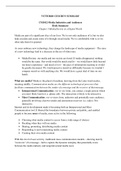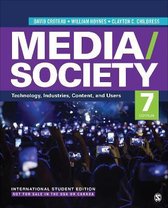VITTORIO CESCHI’S SUMMARY
CM1012-Media Industries and Audiences
Book Summary
Chapter 1-Media/Society in a Digital World
Media are part of a significant slice of our lives. We’re not only audiences of it, but we also
help circulate and create some of it through social media. We’re comfortable with it, so we
often take them for granted.
As users embrace new technology, they change the landscape of media equipment – The raise
of a new technology lead to a decrease in the use of older ones.
• Media/Society: our media and our society are fused. If media disappeared, nothing
would be the same. Our world would be much smaller - we would know little beyond
our direct experience - and much slower - the pace of information reaching us would
be greatly decreased. We would perceive ourselves differently because we wouldn’t
compare ourselves with anything else. We would have a great deal of time on our
hands.
What are media? Media is the plural of medium, deriving from the Latin word medius,
meaning middle. Communication media are the different technological processes that
facilitate communication between the sender of a message and the receiver of that message.
• Interpersonal Communication: one-to-one form, you contact a single person which
you most likely known (i.e. phone call). The interaction is likely to be interactive.
• Mass Communication: one-to-many form, unknown and potentially mass audience,
generally involving a known sender and anonymous receivers (i.e. radio). Not
interactive.
Internet and its development made it becoming both an Interpersonal and Mass
Communication tool. It blurred the boundaries between private and public, and enabled
people to become users of media, more active in the following:
➢ Choosing what media content to access from a wide range of choices
➢ Deciding when they will use media
➢ Sharing, promoting, distributing media content
➢ Responding to and commenting media content
➢ Creating their own media content
With this level of user activity, traditional mass communication models—showing merely
“receivers” of a message—fail to capture the dynamic interplay that potentially exists
between the media industry and nonprofessional media users
, o The four primary elements of the model have changed:
• “Industry” replaces “sender” to flag the professional and usually commercial nature of
media organizations responsible for most media content.
• The term “content” replaces “messages” to better reflect the wide range of media
subjects as experienced by users.
• “Technology” replaces “medium” to isolate the material elements of media.
• “Users,” actively consume content created by industry professionals and create their
own content, replace “receivers.”
o A vital new element-the social world-includes a variety of social forces and non-
media actors affecting the communication process (i.e. cultural norms, government
regulations...).
o The arrows indicating contact are double-headed, reflecting the interactive nature of
media
o The model is circular rather than linear, suggesting the endless feedback loops
occurring among these components.
It is common to see references to sociological theories and concepts in the communication
literature. In turn, sociologists draw on the work of media studies and communications
scholars. But although they can overlap, there is a difference between these disciplines:
• The field of media or communications studies is defined by a particular substantive
area of interest, whereas sociology is a perspective that is applied to a wide range of
substantive areas, including the media
A sociological perspective encourages us to see and understand the relationships between
individuals and the broader social context in which they live: in order to understand people’s
actions you must consider the larger social context in which they occur.
Collectively, people have created the social world, and in turn, they are influenced by it.
,Sociologists often link discussions of interaction and social relations to the concepts of
structure and agency. Structure suggests constraint on human action, and agency indicates
independent action. Combined, the push-pull interactions that result from structure and
agency are essential to understanding social life, the media included.
Structure: social structure describes any recurring pattern of social behaviour (we can see
family structure, for instance, as a pattern of behaviours associated with the culturally defined
idea of family).
➢ Structures can be enabling; they help people achieve something.
➢ Structures can be restrictive; they limit the options of many people.
Agency: agency is intentional and undetermined human action. Human agency
reproduces/changes social structure. While structure constrains agency, it is human agency
that either alters or maintains social structures.
One reason why media are controversial is that different groups have different expectations
and objectives about media and their use (i.e. for users: source of entertainment and
information; for media workers: jobs offer, income, prestige…)
The tension between structure and agency is present on at least three levels of analysis:
• Relationships between Media and other Social Institutions: Tension between
structure and agency produced by different institutions. How do social structures,
such as government and the economy, affect the media industry? How does the media
industry influence other social structures?
➢ Not possible to understand media system without considering the
social, economic and political context in which it exists.
➢ Legal and economic limits set by dominant institutions influencing
media institutions
➢ In turn, media industry has agency if acting on its own and perhaps
influencing other social institutions
➢ In democratic societies, in theory, media are free of severe constraint
by the government and thus have significant agency, constraining
influence over other institutions
➢ In the real world, there is always a mixture of structural constraint and
independent agency.
• Relationships within the Media Industry: We have to understand the context in
which media workers work to understand the decisions made by them.
➢ The sociological emphasis is on social positions, roles, and practices,
not on particular individuals. This leads to norms and expectations
associated with different positions.
➢ Within the media industry, the tension between structure and agency is
related primarily to how much autonomy media personnel have in
doing their work, which will depends on the position occupied.
, ➢ Structural considerations may significantly affect the individual agency
of media personnel.
➢ The collective agency of those who work in the media has the potential
to alter the structures that constrain individual media professionals.
• Relationships between the Media and the Public: How media content and
technology potentially influence users and how media users can impact the media
industry and the content it produces.
➢ Media users are not passive, they are often active on several fronts
➢ Media content doesn’t allow for an intimate interaction of sender and
receiver that characterizes interpersonal communication. Therefore,
users rely on other resources to make sense of the messages in media.
➢ Our own individual interpretations of the media are constantly drawn
on collective resources and experiences that are shaped by social
factors.
➢ Users are not completely immune to the impact of media content and
media technology. There’s a dynamic interplay between the power of
social structure and media technology.
A model of Media and the Social World: four components represented by a separate box
making up the core of the model. All elements are simultaneously part of and surrounded by
the social world. The representation is arbitrary (no top, no bottom), is a circular process.
➢ Industry represents the media industry, meaning the entire organizational structure
making up media, including all media personnel. Industry is affected by changes in
Technology, but is also instrumental in influencing the direction and application of it.
Industry is the producer of media Content. However, the conventions of particular
genres of media products also influence the creators of the content. Users may be
influence by media content, but they must actively interpret meaning from that
content. With the development of technology (internet), users are now able to create
content.
➢ The social world: contains all the social elements not included in the four main boxes
(i.e. governments are non-media social factors that influence all the elements of the
model).
➢ This model is meant to identify some key components in the sociology of media and
to clarify the relationships among these components.
Social construction of reality: actively creating meaning or negotiating the meaning of a
reality. The same is true for the meaning of messages in media content.
Examples to apply the model:
1. Mid-20th-Century Civil Rights Movement:
➢ Industry-content: Media created content about the civil rights movement but
journalist wrote stories to fit a convention of balanced presentation of facts-
they were not supposed to offer their opinion about the story at hand.






